HONDA CRV 2023 User Guide
Manufacturer: HONDA, Model Year: 2023, Model line: CRV, Model: HONDA CRV 2023Pages: 719, PDF Size: 13.43 MB
Page 11 of 719
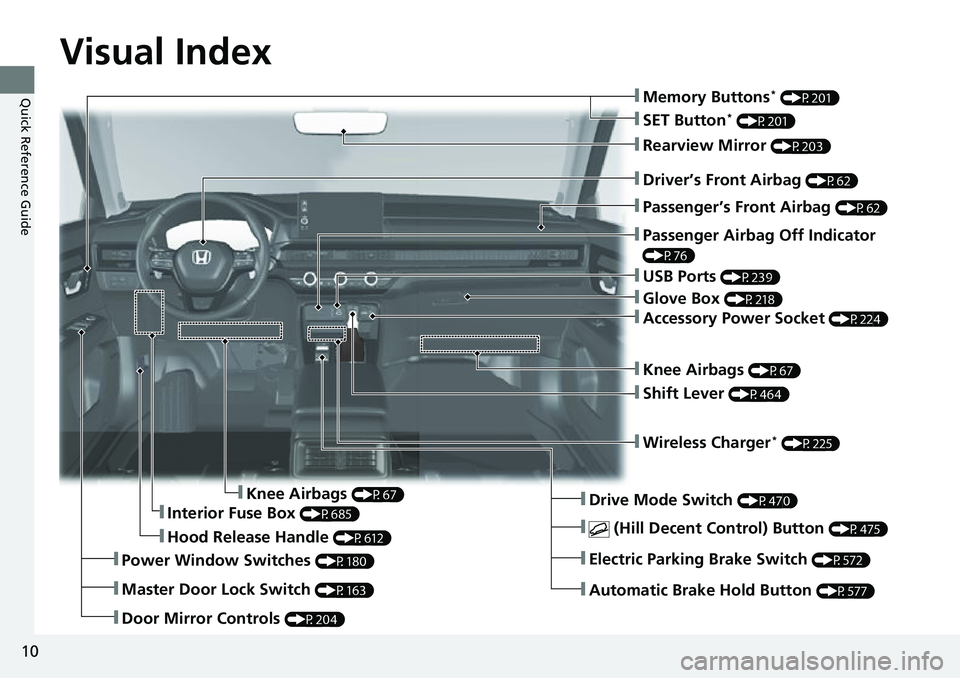
Visual Index
10
Quick Reference Guide
ŌØÜDoor Mirror Controls (P204)
ŌØÜHood Release Handle (P612)
ŌØÜDriverŌĆÖs Front Airbag (P62)
ŌØÜRearview Mirror (P203)
ŌØÜKnee Airbags (P67)
ŌØÜPassenger Airbag Off Indicator
(P76)
ŌØÜInterior Fuse Box (P685)
ŌØÜPassengerŌĆÖs Front Airbag (P62)
ŌØÜKnee Airbags (P67)
ŌØÜWireless Charger* (P225)
ŌØÜUSB Ports (P239)
ŌØÜDrive Mode Switch (P470)
ŌØÜAutomatic Brake Hold Button (P577)
ŌØÜElectric Parking Brake Switch (P572)
ŌØÜ (Hill Decent Control) Button (P475)
ŌØÜPower Window Switches (P180)
ŌØÜMaster Door Lock Switch (P163)
ŌØÜGlove Box (P218)
ŌØÜAccessory Power Socket (P224)
ŌØÜShift Lever (P464)
ŌØÜSET Button* (P201)
ŌØÜMemory Buttons* (P201)
Page 12 of 719
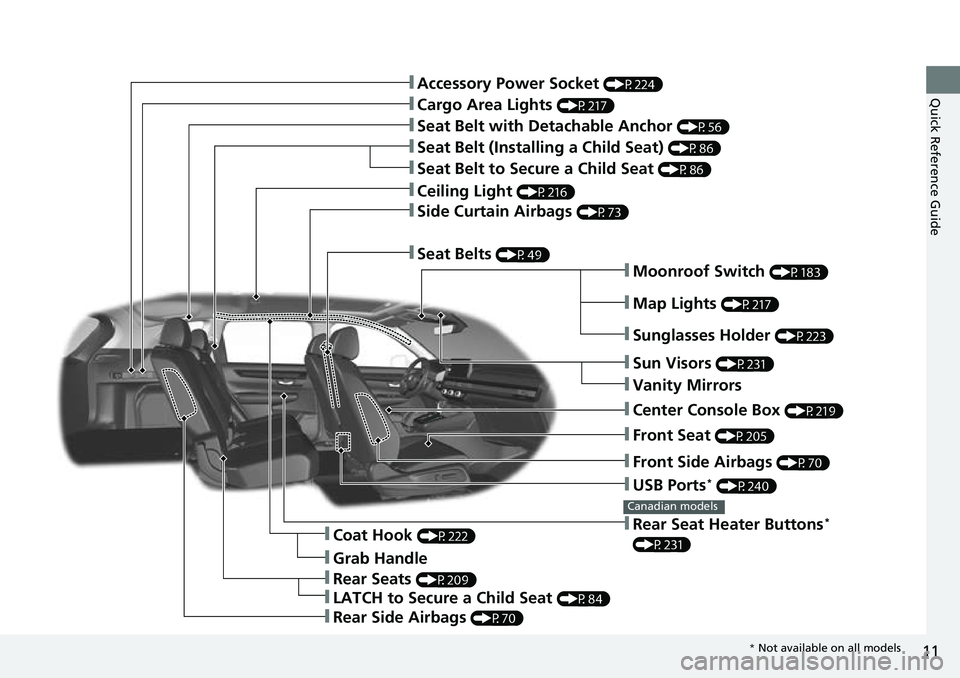
11
Quick Reference Guide
ŌØÜMoonroof Switch (P183)
ŌØÜFront Side Airbags (P70)
ŌØÜMap Lights (P217)
ŌØÜUSB Ports* (P240)
ŌØÜFront Seat (P205)
ŌØÜSun Visors (P231)
ŌØÜVanity Mirrors
ŌØÜRear Seat Heater Buttons*
(P231)
Canadian models
ŌØÜSunglasses Holder (P223)
ŌØÜCenter Console Box (P219)
ŌØÜRear Seats (P209)
ŌØÜLATCH to Secure a Child Seat (P84)
ŌØÜGrab Handle
ŌØÜCoat Hook (P222)
ŌØÜRear Side Airbags (P70)
ŌØÜSeat Belts (P49)
ŌØÜSide Curtain Airbags (P73)
ŌØÜSeat Belt with Detachable Anchor (P56)
ŌØÜCargo Area Lights (P217)
ŌØÜSeat Belt to Secure a Child Seat (P86)
ŌØÜSeat Belt (Installing a Child Seat) (P86)
ŌØÜAccessory Power Socket (P224)
ŌØÜCeiling Light (P216)
* Not available on all models
Page 13 of 719
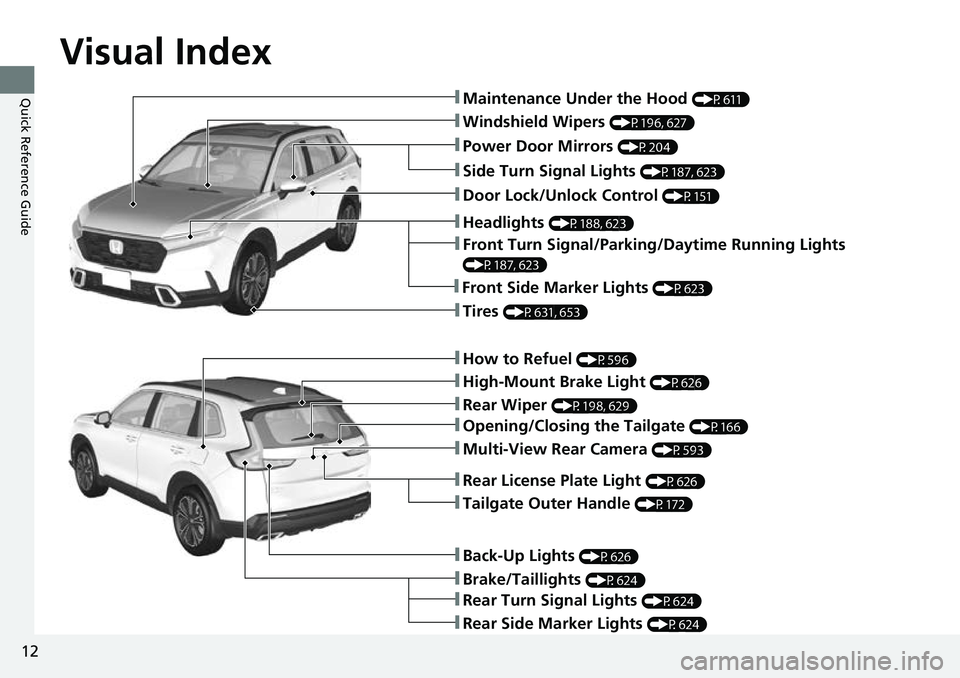
Visual Index
12
Quick Reference Guide
ŌØÜWindshield Wipers (P196, 627)
ŌØÜHow to Refuel (P596)
ŌØÜHigh-Mount Brake Light (P626)
ŌØÜRear Wiper (P198, 629)
ŌØÜBrake/Taillights (P624)
ŌØÜPower Door Mirrors (P204)
ŌØÜMaintenance Under the Hood (P611)
ŌØÜMulti-View Rear Camera (P593)
ŌØÜFront Turn Signal/Parking/Daytime Running Lights
(P187, 623)
ŌØÜTires (P631, 653)
ŌØÜOpening/Closing the Tailgate (P166)
ŌØÜSide Turn Signal Lights (P187, 623)
ŌØÜHeadlights (P188, 623)
ŌØÜRear Turn Signal Lights (P624)
ŌØÜRear Side Marker Lights (P624)
ŌØÜBack-Up Lights (P626)
ŌØÜFront Side Marker Lights (P623)
ŌØÜTailgate Outer Handle (P172)
ŌØÜRear License Plate Light (P626)
ŌØÜDoor Lock/Unlock Control (P151)
Page 14 of 719
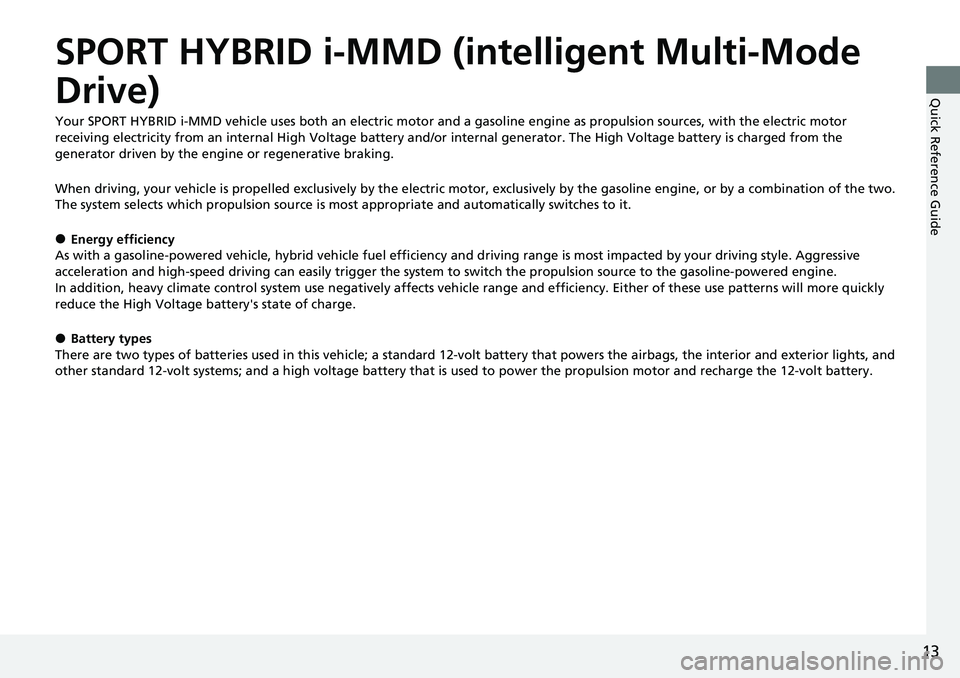
13
Quick Reference Guide
SPORT HYBRID i-MMD (intelligent Multi-Mode
Drive)
Your SPORT HYBRID i-MMD vehicle uses both an electric motor and a gasoline engine as propulsion sources, with the electric motor
receiving electricity from an internal High Voltage battery and/or internal generator. The High Voltage battery is charged from the
generator driven by the engine or regenerative braking.
When driving, your vehicle is propelled exclusively by the electric motor, exclusively by the gasoline engine, or by a combination of the two.
The system selects which propulsion source is most appropriate and automatically switches to it.
ŌŚÅEnergy efficiency
As with a gasoline-powered vehicle, hybrid vehicle fuel efficien cy and driving range is most impacted by your driving style. Aggressive
acceleration and high-speed driving can easily trigger the system to switch the propulsion source to the gasoline-powered engin e.
In addition, heavy climate control system use negatively affects vehicle range and efficiency. Either of these use patterns will more quickly
reduce the High Voltage battery's state of charge.
ŌŚÅBattery types
There are two types of batteries used in this vehicle; a standard 12-volt battery that powers the airbags, the interior and exterior lights, and
other standard 12-volt systems; and a high voltage battery that is used to power the propulsion motor and recharge the 12-volt battery.
Page 15 of 719
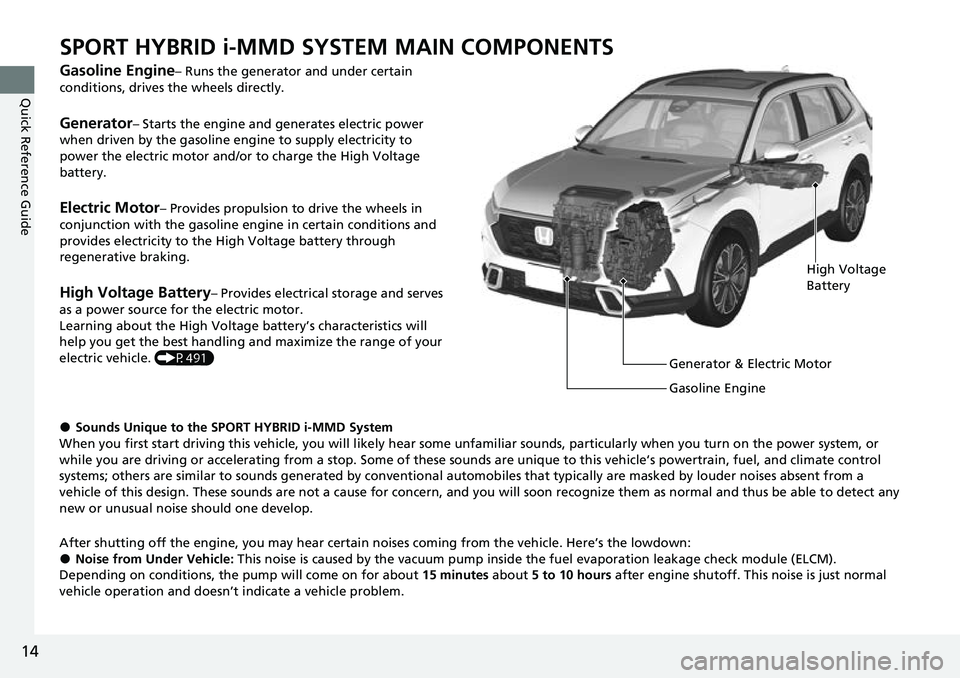
14
Quick Reference Guide
SPORT HYBRID i-MMD SYSTEM MAIN COMPONENTS
Gasoline EngineŌĆō Runs the generator and under certain
conditions, drives the wheels directly.
GeneratorŌĆō Starts the engine and generates electric power
when driven by the gasoline engine to supply electricity to
power the electric motor and/or to charge the High Voltage
battery.
Electric MotorŌĆō Provides propulsion to drive the wheels in
conjunction with the gasoline engine in certain conditions and
provides electricity to the High Voltage battery through
regenerative braking.
High Voltage BatteryŌĆō Provides electrical storage and serves
as a power source for the electric motor.
Learning about the High Voltage batteryŌĆÖs characteristics will
help you get the best handling and maximize the range of your
electric vehicle. (P491)
ŌŚÅSounds Unique to the SPORT HYBRID i-MMD System
When you first start driving this vehicle, you will likely hear some unfamiliar sounds, particularly when you turn on the power system, or
while you are driving or accelerating from a stop. Some of these sounds are unique to this vehicleŌĆśs powertrain, fuel, and clim ate control
systems; others are similar to sounds generate d by conventional automobiles that typically are masked by louder noises absent f rom a
vehicle of this design. These sounds are not a cause for concern, and you will soon recognize them as normal and thus be able t o detect any
new or unusual noise should one develop.
After shutting off the engi ne, you may hear certain noises coming from the vehicle. HereŌĆÖs the lowdown:
ŌŚÅNoise from Under Vehicle: This noise is caused by the vacuum pump inside the fuel evaporation leakage check module (ELCM).
Depending on conditions, the pump will come on for about 15 minutes about 5 to 10 hours after engine shutoff. This noise is just normal
vehicle operation and doesnŌĆÖt indicate a vehicle problem.
High Voltage
Battery
Generator & Electric Motor
Gasoline Engine
Page 16 of 719
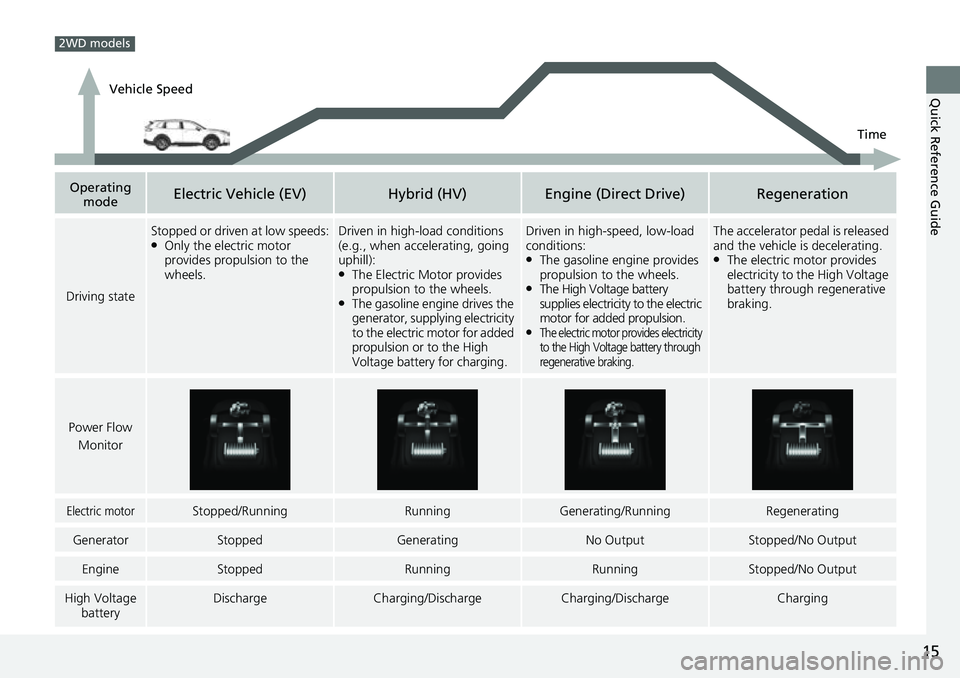
15
Quick Reference Guide
Operating modeElectric Vehicle (EV)Hybrid (HV)Engine (Direct Drive)Regeneration
Driving state
Stopped or driven at low speeds:ŌŚÅOnly the electric motor
provides propulsion to the
wheels.Driven in high-load conditions
(e.g., when accelerating, going
uphill):
ŌŚÅThe Electric Motor provides
propulsion to the wheels.
ŌŚÅThe gasoline engine drives the
generator, supplying electricity
to the electric motor for added
propulsion or to the High
Voltage battery for charging.
Driven in high-speed, low-load
conditions:
ŌŚÅThe gasoline e ngine provides
propulsion to the wheels.
ŌŚÅThe High Voltage battery
supplies electricity to the electric
motor for added propulsion.
ŌŚÅThe electric motor provides electricity
to the High Voltage battery through
regenerative braking.
The accelerator pedal is released
and the vehicle is decelerating.
ŌŚÅThe electric motor provides
electricity to the High Voltage
battery through regenerative
braking.
Power Flow
Monitor
Electric motorStopped/RunningRunningGenerating/RunningRegenerating
GeneratorStoppedGeneratingNo OutputStopped/No Output
EngineStoppedRunningRunningStopped/No Output
High Voltage batteryDischargeCharging/DischargeCharging/DischargeCharging
2WD models
Vehicle Speed
Time
Page 17 of 719
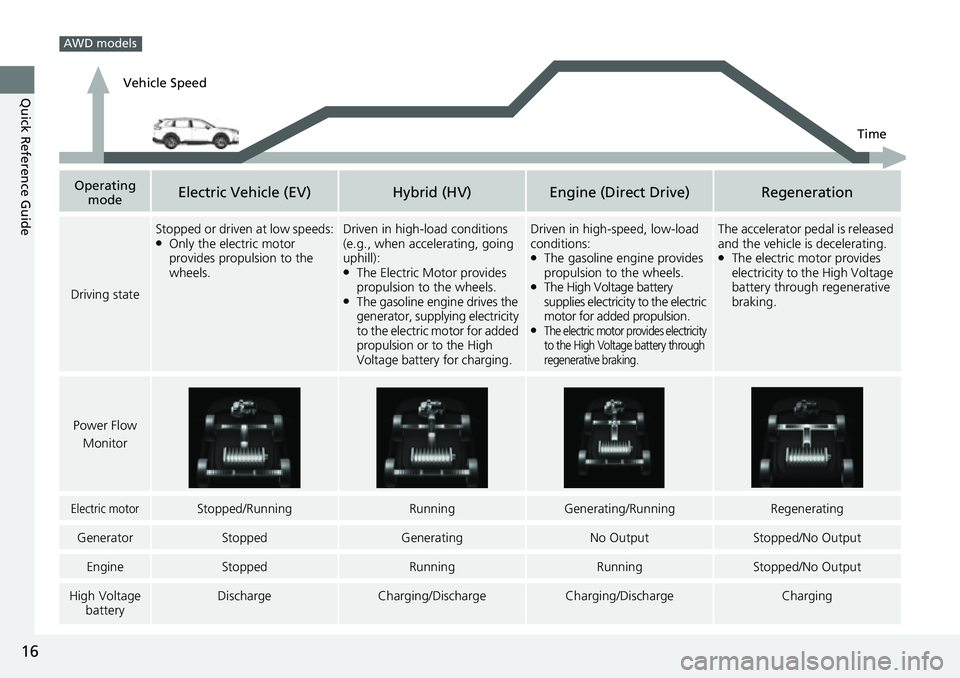
16
Quick Reference Guide
Operating modeElectric Vehicle (EV)Hybrid (HV)Engine (Direct Drive)Regeneration
Driving state
Stopped or driven at low speeds:ŌŚÅOnly the electric motor
provides propulsion to the
wheels.Driven in high-load conditions
(e.g., when accelerating, going
uphill):
ŌŚÅThe Electric Motor provides
propulsion to the wheels.
ŌŚÅThe gasoline engine drives the
generator, supplying electricity
to the electric motor for added
propulsion or to the High
Voltage battery for charging.
Driven in high-speed, low-load
conditions:
ŌŚÅThe gasoline engine provides
propulsion to the wheels.
ŌŚÅThe High Voltage battery
supplies electricity to the electric
motor for added propulsion.
ŌŚÅThe electric motor provides electricity
to the High Voltage battery through
regenerative braking.
The accelerator pedal is released
and the vehicle is decelerating.
ŌŚÅThe electric motor provides
electricity to the High Voltage
battery through regenerative
braking.
Power Flow
Monitor
Electric motorStopped/RunningRunningGenerating/RunningRegenerating
GeneratorStoppedGeneratingNo OutputStopped/No Output
EngineStoppedRunningRunningStopped/No Output
High Voltage batteryDischargeCharging/DischargeCharging/DischargeCharging
AWD models
Vehicle Speed
Time
Page 18 of 719
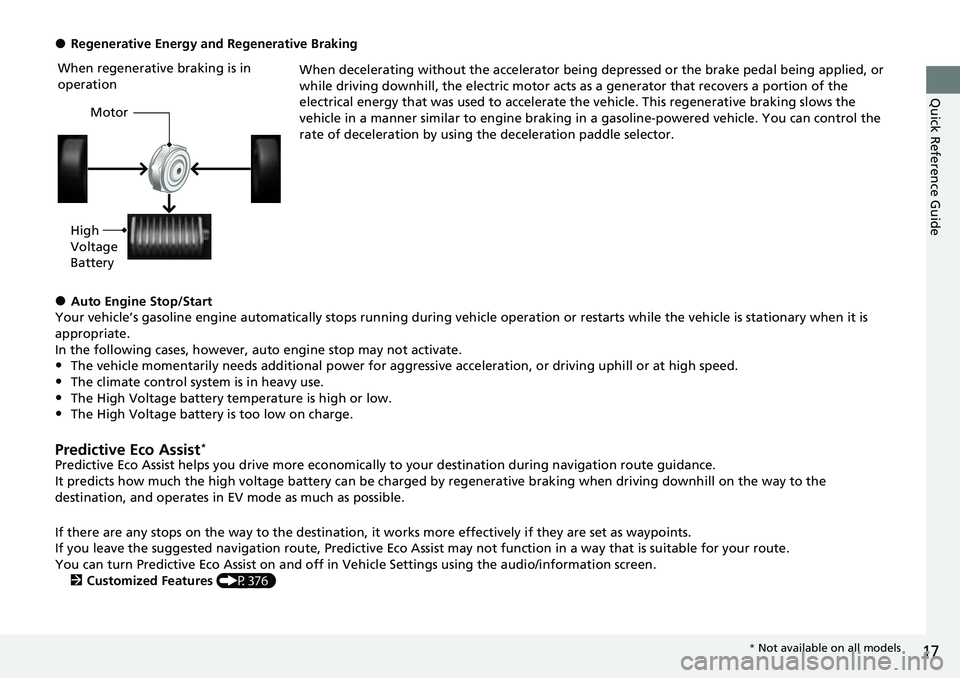
17
Quick Reference Guide
ŌŚÅRegenerative Energy and Regenerative BrakingWhen decelerating without the accelerator being depressed or the brake pedal being applied, or
while driving downhill, the electric motor acts as a generator that recovers a portion of the
electrical energy that was used to accelerate the vehicle. This regenerative braking slows the
vehicle in a manner similar to engine braking in a gasoline-powered vehicle. You can control the
rate of deceleration by using the deceleration paddle selector.
ŌŚÅAuto Engine Stop/Start
Your vehicleŌĆÖs gasoline engine automatically stops running during vehicle operation or restarts while the vehicle is stationary when it is
appropriate.
In the following cases, however, auto engine stop may not activate.
ŌĆóThe vehicle momentarily needs additional power for aggressive acceleration, or driving uphill or at high speed.
ŌĆóThe climate control system is in heavy use.
ŌĆóThe High Voltage battery temperature is high or low.ŌĆóThe High Voltage battery is too low on charge.
Predictive Eco Assist*
Predictive Eco Assist helps you drive more economically to your destination during navigation route guidance.
It predicts how much the high voltage battery can be charged by regenerative braking when driving downhill on the way to the
destination, and operates in EV mode as much as possible.
If there are any stops on the way to the destination, it works more effectively if they are set as waypoints.
If you leave the suggested navigation route, Predictive Eco Assi st may not function in a way that is suitable for your route.
You can turn Predictive Eco Assist on and off in Ve hicle Settings using the audio/information screen.
2 Customized Features (P376)
When regenerative braking is in
operation
Motor
High
Voltage
Battery
* Not available on all models
Page 19 of 719
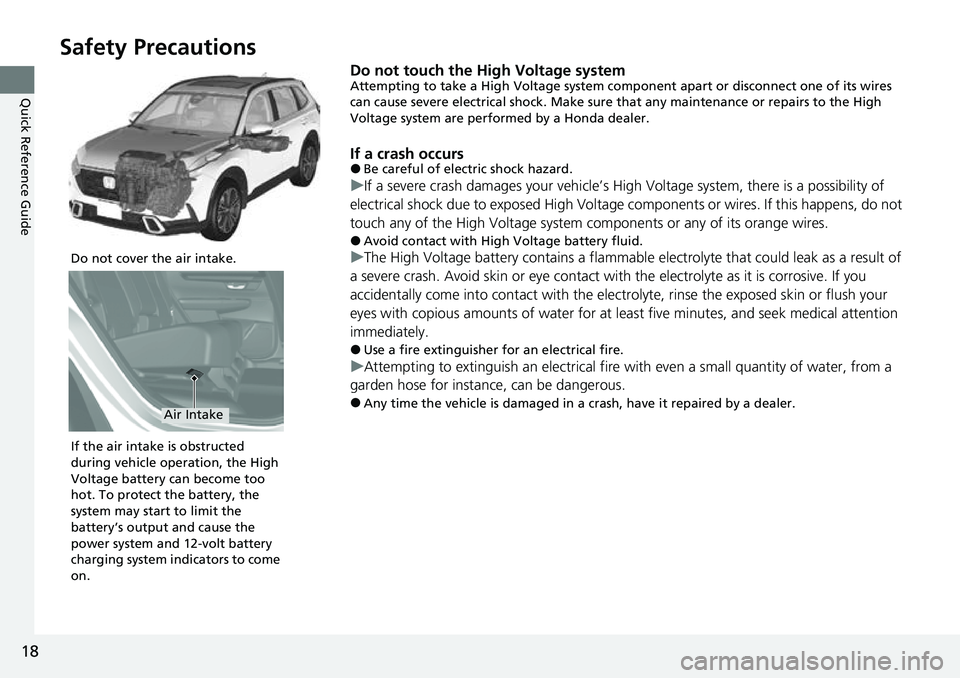
18
Quick Reference Guide
Safety Precautions
Do not touch the High Voltage systemAttempting to take a High Voltage system component apart or disconnect one of its wires
can cause severe electrical shock. Make sure that any maintenance or repairs to the High
Voltage system are performed by a Honda dealer.
If a crash occursŌŚÅBe careful of electric shock hazard.
uIf a severe crash damages your vehicleŌĆÖs Hi gh Voltage system, there is a possibility of
electrical shock due to exposed High Voltage components or wires. If this happens, do not
touch any of the High Voltage system components or any of its orange wires.
ŌŚÅAvoid contact with High Voltage battery fluid.
u The High Voltage battery contains a flammable electrolyte that could leak as a result of
a severe crash. Avoid skin or eye contact with the electrolyte as it is corrosive. If you
accidentally come into contac t with the electrolyte, rinse the exposed skin or flush your
eyes with copious amounts of water for at least five minutes, and seek medical attention
immediately.
ŌŚÅUse a fire extinguisher for an electrical fire.
u Attempting to extinguish an electrical fire with even a small quantity of water, from a
garden hose for instance, can be dangerous.
ŌŚÅAny time the vehicle is damaged in a crash, have it repaired by a dealer.
Do not cover the air intake.
If the air intake is obstructed
during vehicle operation, the High
Voltage battery can become too
hot. To protect the battery, the
system may start to limit the
batteryŌĆÖs output and cause the
power system and 12-volt battery
charging system indicators to come
on.
Air Intake
Page 20 of 719
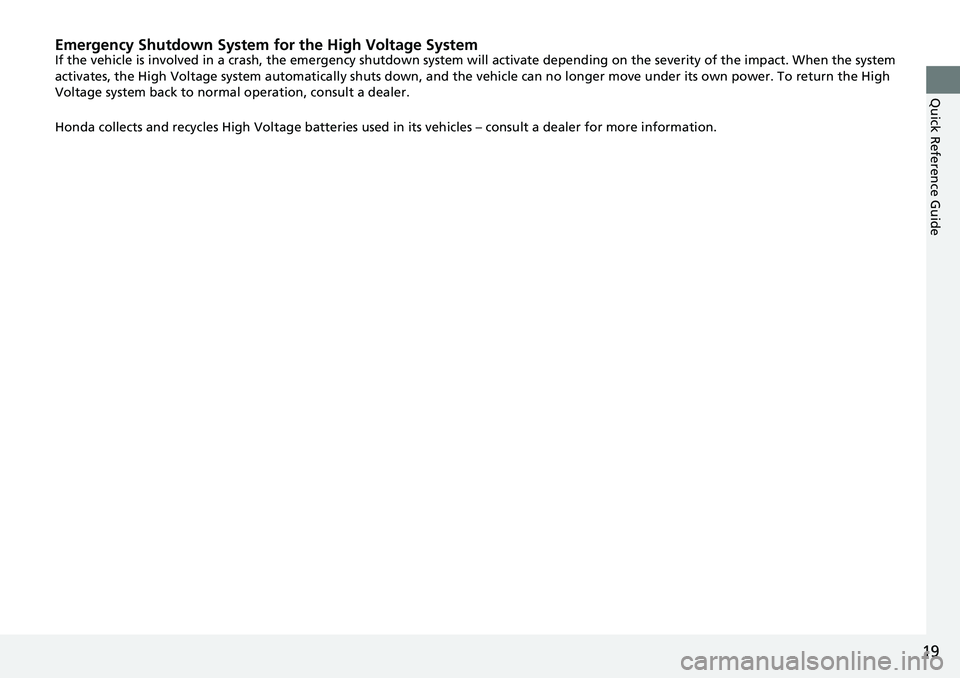
19
Quick Reference Guide
Emergency Shutdown System for the High Voltage SystemIf the vehicle is involved in a crash, the emergency shutdown system will activate depending on the severity of the impact. When the system
activates, the High Voltage system automatica lly shuts down, and the vehicle can no longer move under its own power. To return the High
Voltage system back to normal operation, consult a dealer.
Honda collects and recycles High Voltage batteries used in its vehicles ŌĆō consult a dealer for more information.